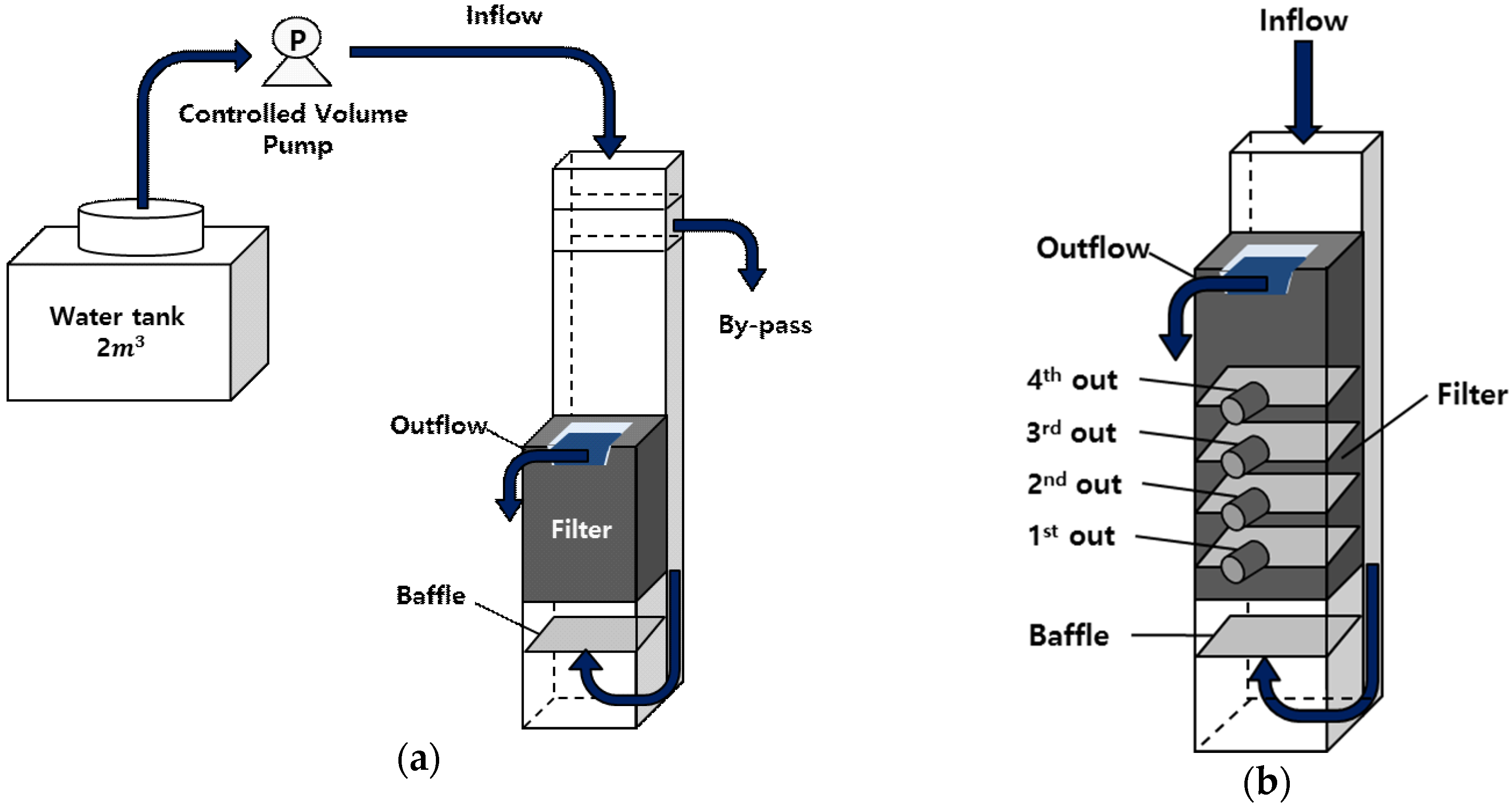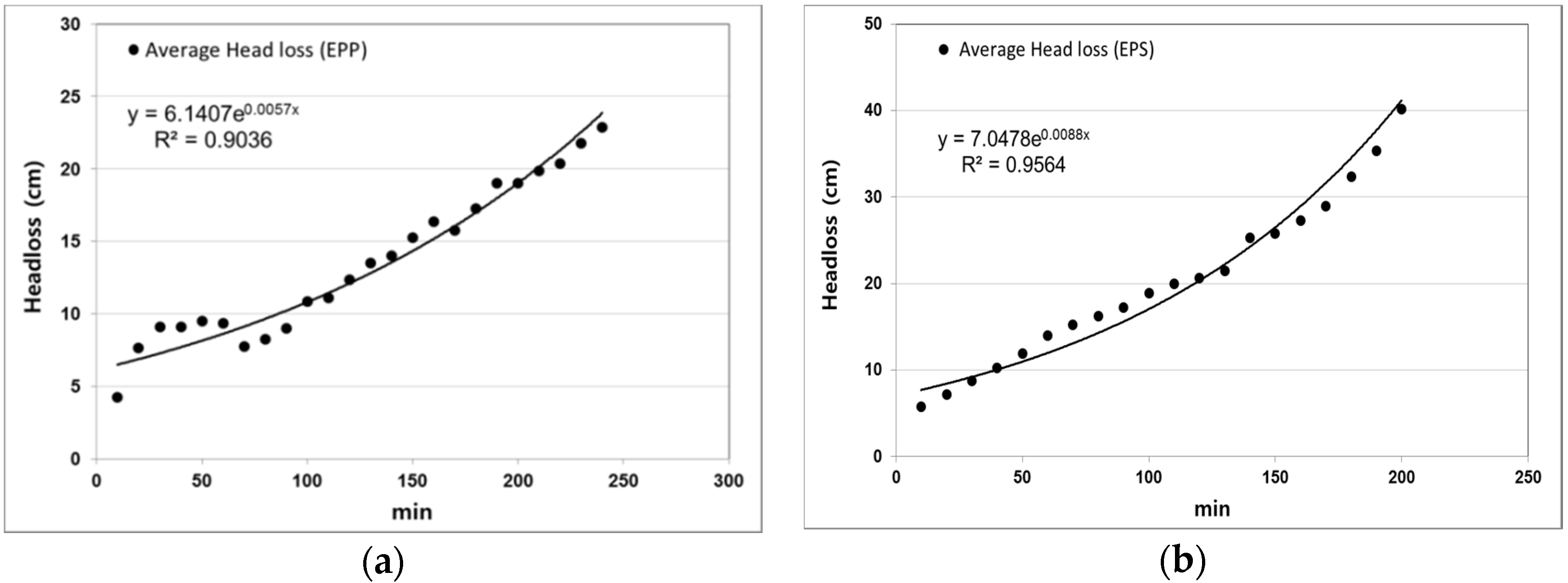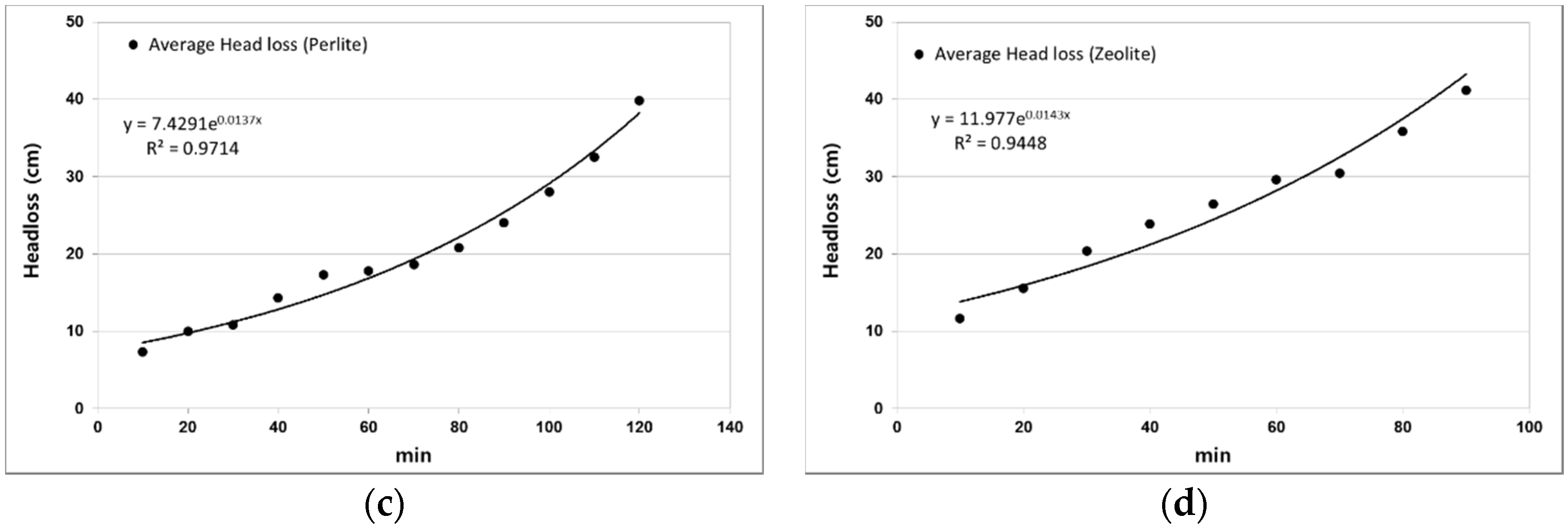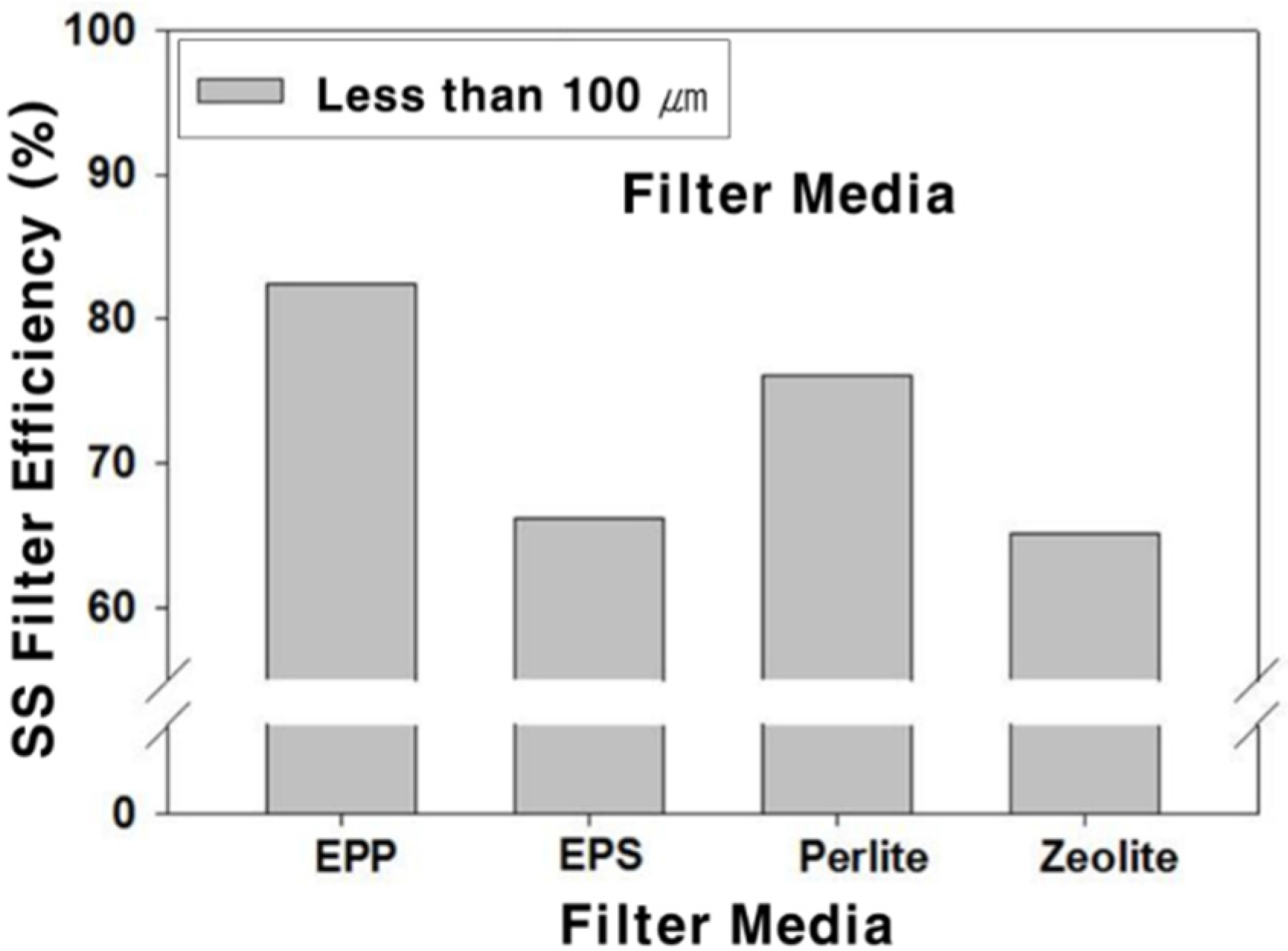4.1. Hydraulic Characteristics for Each Media
Experimental conditions were the same for each filter media, except that the concentration of inflow raw water differed according to the difference in road surface dust mixed in the course of the experiment. The rate of inflow for each filter media was set at a constant filtration velocity of 950 m/day based on filtration cross-sectional area (289 cm
2) of experimental equipment by using a standard pump and pouring inflow of 1.144 m
3/h constantly through the flow rate control valve. The result of head loss measurement for each filter media by road runoff during the procedure period up to 4 h are shown in
Table 6.
Zeolite showed the shortest time to reach the head loss limit overflow, which was only 90 min. Perlite and EPS respectively took 120 and 200 min. It was also confirmed that the average head loss of EPP was 23, so overflow did not happen, even after 240 min. To standardize the head loss for each filter media, the head loss over time was expressed in an exponential function and the result of the regression is shown in
Figure 2 and
Table 7.
The exponential function from the regression of charts in
Figure 2 can be expressed as,
where Y(m) is head loss, a and b are unitless regression coefficients, and x(min) is elapsed time.
For each filter medium, the time taken to reach the maximum head loss of 40 cm was recorded, and it took 215, 134, 104 min, respectively, for EPS, perlite, and zeolite, and the result was very similar to the calculation made by the experiment. EPP did not reach the head loss until 240 min into the experiment, but calculation by log function was shown to be 357 min.
Among the filter media used in the experiment, zeolite was the only non-buoyant filter media that has a specific gravity greater than 1, and by operating with upward type, the concentrated filtration of particulate pollutants occurred at the bottom of the filter layer, which seemed to cause the rapid blockage of the filter medium. Among buoyant filter media, for perlite the limit head loss was reached in the shortest time because the filter media is crushed when operating at maximum linear velocity and generates fine particles. They accumulate at the bottom of the filter layer in which particulate pollutants are mixed and this causes the limit head loss to be reached more quickly.
In the case of EPP and EPS, the crushing of the filter media by high filtration velocity as in perlite was not observed. However, we propose that the physical differences in the porosity of the two filter media, the specific surface area, and the distribution of micro pores causes EPP to show a lower increase of head loss over time compared to EPP. It was shown that the impact of hydraulic loads on head loss over filtration time for four types of filter media could be ordered as follows: zeolite > perlite > EPS > EPP, which suggests that EPP is impacted the least by hydraulic loads compared to other filter media. Therefore, EPP is the most suitable media for NPS reduction facilities operating at high filtration linear velocities for the treatment of road runoff.
4.2. Filtration Characteristics According to the Filter Media
For the four selected filter media (EPP, EPS, perlite, zeolite), to test the filtration treatment efficiency for road runoff, the filtration linear velocity was set to 950 m/day—the maximum velocity of filtration treatment facilities proposed by the Ministry of Environment, and the limitation head was set to 40 cm, considering the economic and field applicability conditions of the treatment facilities. For each filter media, the change in head loss over time, four water quality parameters (SS, COD, Zn, Cu) before and after treatment, and particle size analysis were conducted.
For each filter medium, the average SS influent concentration for road runoff was in the range of, on average, 718.7 mg/L–901.3 mg/L; for EPP, EPS, perlite and zeolite, they were respectively 71.9 mg/L, 98.3 mg/L, 95.4 mg/L, and 116.7 mg/L, and the average treatment efficiencies were 89.0%, 85.3%, 88.5%, and 84.9%, respectively. Zeolite showed the lowest efficiency and EPP showed the highest. In the experimental procedure, there was a massive difference in the concentration of influent according to the inflow time and the amount of the road surface dust mixed into the influent, but regardless of the type of filter media, the quality of treated water showed quite a constant concentration range, and treatment efficiency was over 80%. When we look at each filter media, zeolite, which showed the lowest SS treatment efficiency, suddenly showed a treatment efficiency lower than 80%. It was determined that the reason is because of the temporary exposure of micro-particles collected at the filter layer 40 to 70 min after the experiment started at the high filtration linear velocity of 950 m/day. For perlite, the filter media was gradually crushed over time, and from 80 min after the experiment (when head loss drastically increased), the treatment efficiency tended to decrease gradually. In the case of EPS, after 10 min from the beginning of the experiment, the average SS treatment efficiency was the lowest at 78.4%. It was determined that the efficiency temporary decreased because the filter layer was not yet stabilized. EPP showed a stable treatment efficiency over time of over 85% without any increase or decrease in efficiency.
The results of treatment efficiency, average COD concentrations of treated water, and influent over time classified by filter media are shown in
Table 8.
For each filter medium, the average COD influent concentration for road runoff was in the range of 107.7 mg/L–193.6 mg/L; for EPP, EPS, Perlite, and zeolite, they were respectively 16.8 mg/L, 37.2 mg/L, 29.3 mg/L, and 33.3 mg/L, and the average treatment efficiency of SS was over 80%, which was similar for all filter media. However, for the treatment efficiency of COD, only EPP filter media showed the high treatment efficiency of 89%, and other filter media showed lower treatment efficiencies ranging about 63.4%–80.2% compared to the SS category. In the previous case study about removal property of contaminants in storm water runoff by filter media, Kim
et al. (2009) reported that COD removal efficiency was 70%–92% when studying perlite and synthetic filter media of polystyrene lines, and Lee and Kim (2008) reported that removal efficiency of COD was over 90% for the treatment device combined with zeolite filter media and eddy current [
18,
19]. Lee and Kim also suggested a correlation between categories of each pollutant by early-stage storm water runoff and reported that the correlation of COD for SS were 0.756–0.962. In addition, they reported that if the total amount of SS elimination through filter media was taken as 1, COD could remove 0.92, which was the highest value [
19].
Among the heavy metals that are included in the storm water runoff of urban areas, Zn and Cu are pollutants caused by the transportation of vehicles, and most heavy metals are attached to buoyant materials. Moreover, it has been reported that the concentration of heavy metals generally increases as the particles size decreases; the highest concentrations are shown at sizes below 50 μm [
20,
21]. Park
et al. (2007) monitored the five categories (Zn, Cu, Pb, Cr, Cd) of heavy metals in road runoff for 2 years and reported that reduction measures concentrating on Zn and Cu are necessary because the concentration of Zn and Cu were higher compared to others due to the usage of brakes and the wearing of tires [
22].
Kim
et al. (2009) reported that, for dissolved materials and organic substances, the absorption of dissolved organic substances through the chemical properties of filter media, such as ion exchange within filter media or electrical force, are very low (average 10%), despite research about the removal characteristics of dissolved materials by filter media. In addition, they reported that several hours of contact time (according to their chemical properties) are needed in order to remove the pollutants [
18].
The average Zn influent concentration for road runoff was in the range of 1.33 mg/L–2.43 mg/L; for EPP, EPS, perlite, and zeolite, they were respectively 0.33 mg/L, 0.54 mg/L, 0.42 mg/L, and 0.88 mg/L. The average Cu influent concentration for road runoff was in the range of 1.01 mg/L–1.58 mg/L for EPP, EPS, perlite, and zeolite were 0.17 mg/L, 0.36 mg/L, 0.20 mg/L, and 0.36 mg/L, respectively. Looking at the average removal efficiency for each filter medium, in the case of Zn, a treatment efficiency decrease can be organized in the following order: EPP (77.1%) > perlite (72.2%) > zeolite (63.6%) > EPS (59.7%). In the case of Cu, the order is as follows: EPP (88.2%) > perlite (82.1%) > zeolite (72.0%) > EPS (65.1%), which indicates that for both cases, EPP shows the highest treatment efficiency, while EPS shows the lowest. The average dissolved Zn and Cu concentration ratio of influent for each filter medium were observed to be 6.6%–13.5% for Zn and 4.1%–7.0% for Cu. It was determined that the dissolved concentration ratio result was very low compared to preceding research cases, where the dissolved ratio of heavy metals in road runoff that are classified under the size of 0.45 μm make up more than 50% of the heavy metals because the experiment was conducted by randomly manufactured influent.
To sum up, it is proposed that the removal mechanism of heavy metals present in road runoffs mostly depends on physical collection by the filter media according to its characteristics; among the four filter media used in this experiment, the EPP filter media’s micro-pores proved most advantageous in removing heavy metals that contain a lot of particulate substances, and EPS filter media are less advantageous.
4.3. Removal Rate of Each Medium
4.3.1. Particle Size Distribution of Outflow by Filtration
In order to determine the removal mechanism for micro-particles that have relatively-greater pollutant loads in samples collected over time in road runoff for each filter medium, the particle size analyses were conducted at 30 min intervals, and the results are shown in
Table 9.
As the particle size of water treated by filter media compared to influent gets smaller, the removal of micro-particles is at an advantage and it can be indirectly determined that the treatment efficiency decreases for particle sizes lower than that. The particle size of motorway runoff pollutant was analyzed between 78.1 μm and 317.3 μm in size, for particles that fall under the volume ratio within 50%–90% of the average particle size distribution. The results showed that D (0.1) was in the range of 2.6 μm–4.4 μm, D (0.5) was in the range of 14.4 μm–25.7 μm, and D (0.9) was in the range of 68.6 μm–98.5 μm.
For each filter media, excluding D (0.1) for which the size is similar, the D (0.5) of treated water can be organized in decreasing order as follows: perlite (25.7 μm) > EPS (21.6 μm) > EPP (18.9 μm) > zeolite (14.4 μm). D (0.75) of treated water can be organized in decreasing order as follows: perlite (53.5 μm) > EPS (48.1 μm) > EPP (38.6 μm) > zeolite (33.4 μm). D (0.9 μm) of treated water can be organized in decreasing order as follows: EPS (98.5 μm) > perlite (89.3 μm) > EPP (70.9 μm) > zeolite (68.6 μm). Therefore, zeolite showed the smallest particle size and perlite and EPS showed larger particle size compared to other filter media.
Looking at the change in particle size distribution over time, the particle size of outflow tended to increase gradually for all media except zeolite. It is determined that the reason for this comes from the gradual blockage of pores caused by collection of micro-particles on pores and the greatest increase of size was shown for EPS filter media and D (0.9) which corresponds to 90% volume ratio.
4.3.2. Efficiency Classified by Particle Size Distribution
For each filter medium, SS treatment efficiency, classified by size distribution, was calculated along with the size distribution and SS results of influent and treated water over time. When calculating the SS treatment efficiency, all particles were assumed to be spherical and the range of particle sizes was classified into nine steps (less than 100: step 6, over 100: step 3). The specific gravity for each particle size was referred to the specific gravity classified by road surface dust particle size proposed by USEPA and classified into 3 steps (less than 30 μm: 2.14, 30 μm–60 μm: 2.15, over 60 μm: 2.6).
The calculation process of SS removal efficiency classified by particle size distribution was as follows: volume ratio was deducted from the particle size distribution results, and this result was then converted to weight ratio by applying the specific gravity corresponding to the range of particle size and SS loads (g), classified by particle size distribution and treatment efficiency, and calculated by applying the SS concentration to the converted weight ratio.
The calculation results of SS treatment efficiency, classified by particle size distribution and calculated for each filter medium is shown in
Table 10.
Regardless of the type of filter media, the range of particle sizes greater than 100 μm had over 95% of treatment efficiency, whereas in the range of particle sizes under 100 μm, the treatment efficiency tended to decrease as the particle size decreased. Classifying by filter media, zeolite and EPS showed a greater decrease in treatment efficiency based on the decrease in particle size compared to EPP and perlite. For particles with sizes greater than 100 μm, the treatment efficiency was high, and it is determined that the reason for this is that they precipitate at the bottom before they are exposed passing through the filter media in an upward system. For particles with a size less than 100 μm, which are treated by collecting while passing through the filter media, treatment efficiency varied according to the properties of filter media.
Figure 3 shows the average SS removal efficiency by each filter medium for micro-particles with size less than 100 μm. The efficiency was shown to be in decreasing order as follows: EPP (82.4%) > perlite (76.1%) > EPS (66.2%) > zeolite (65.2%), which confirmed the fact that EPP filter media are more favorable compared to other filter media for the treatment of micro-particles that have high pollutant loads. For EPP filter media, the treatment efficiency according to particle size distribution is more than 80% for small particles under 30 μm. Therefore, EPP can manage the broad size range of pollutant particles.
For EPS, perlite, and zeolite filter media, their treatment efficiency is more than 80% for particles over 40 μm—quite a small treatment range.














